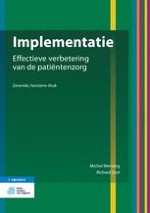Samenvatting
Implementatieprojecten omvatten kleinschalige en grootschalige verbeterprojecten met begeleidende evaluatie en onderzoeken naar implementatiestrategieën. Om veranderingen te kunnen toeschrijven aan een strategie en ze te kwantificeren, moet een gecontroleerd studiedesign worden toegepast. Dit kan verklarend of pragmatisch zijn of hier ergens tussenin liggen. Idealiter volgt de ontwikkeling van een implementatiestrategie een stapsgewijze aanpak, zoals beschreven voor complexe interventies in het algemeen. Er zijn veel designs voor gerandomiseerd gecontroleerde experimenten beschikbaar, zoals studies met meerdere armen, factorieel design, blokdesigns en stepped wedge design. Deze hebben elk hun sterke en zwakke punten. In veel implementatieprojecten is sprake van clustering van gegevens. Hiermee dient rekening te worden gehouden in het ontwerp, de omvang en de analyse van de evaluatie, onder meer door clusters te randomiseren in plaats van patiënten. Tot de niet-gerandomiseerde gecontroleerde experimenten worden gerekend: quasi-experimentele studies, gecontroleerde voor-nastudies en tijdreeksanalyses. Niet-gecontroleerde voor-nastudies liggen op de grens van gecontroleerde en observationele evaluatie. Gecontroleerde studies hebben over het algemeen een hogere interne validiteit, maar een lagere externe validiteit dan observationele designs voor evaluatie van interventies.
